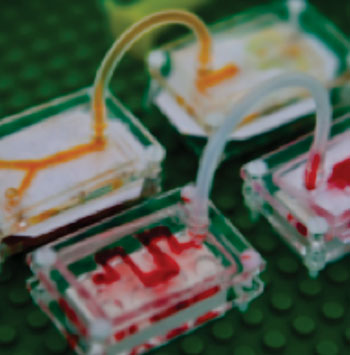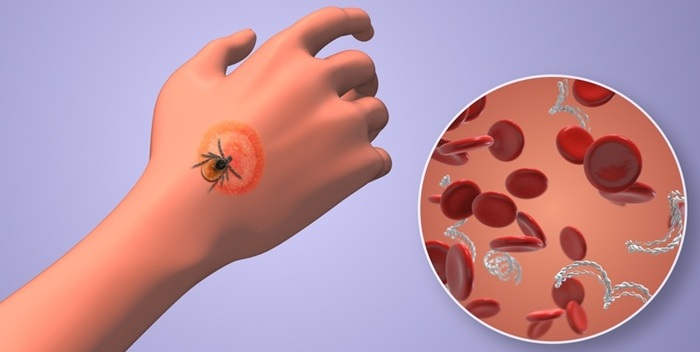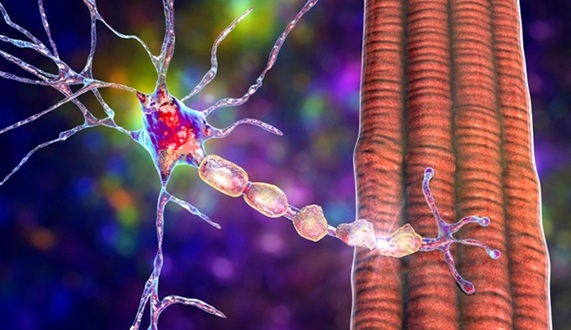Rapid Lateral Flow Assay Detects Several Viral Fevers Simultaneously
|
By LabMedica International staff writers Posted on 10 Mar 2015 |

Image: The diagnostic system is based on triangular silver nanoparticles that display different colors depending on their size (Photo courtesy of the Massachusetts Institute of Technology).
A team of biomedical engineers has developed a rapid diagnostic test that is able to detect several viruses such as Ebola, dengue fever, and yellow fever simultaneously from a single sample of patient's serum.
Investigators at the Massachusetts Institute of Technology (Cambridge, MA, USA) and Harvard Medical School (Boston, MA, USA) used a novel class of silver nanoparticles to drive a paper-based lateral flow assay. Lateral flow assays are commonly used to detect such pathogens as Rotavirus, adenovirus, Streptococcus A and B, and gonorrhea and in rapid pregnancy tests.
The investigators extended the usefulness of the lateral flow approach by incorporating antibodies bound to different colored nanoparticles. In the current version of the assay, following a 10 minute incubation, an orange band indicates the presence of yellow fever virus, a red band indicates Ebolavirus, and a green band indicates dengue fever virus.
The investigators expect that their new rapid test will complement more definitive diagnostic technologies, such as PCR. "If you are in a situation in the field with no power and no special technologies, if you want to know if a patient has Ebola, this test can tell you very quickly that you might not want to put that patient in a waiting room with other people who might not be infected," said senior author Dr. Lee Gehrke, professor of microbiology and immunology at Harvard Medical School. "That initial triage can be very important from a public health standpoint, and there could be a follow-up test later with PCR or something to confirm."
This type of diagnostic testing device is readily customizable to detect other infectious diseases, by linking the silver nanoparticles to different antibodies. "Thankfully the Ebola outbreak is dying off, which is a good thing, but what we are thinking about is what is coming next," said Dr. Gehrke. "There will undoubtedly be other viral outbreaks. It might be Sudan virus, or it might be another hemorrhagic fever. What we are trying to do is develop the antibodies needed to be ready for the next outbreak that is going to happen."
The rapid diagnostic test for multiple viral fevers was described in the February 12, 2015, online edition of the journal Lab on a Chip.
Related Links:
Massachusetts Institute of Technology
Harvard Medical School
Investigators at the Massachusetts Institute of Technology (Cambridge, MA, USA) and Harvard Medical School (Boston, MA, USA) used a novel class of silver nanoparticles to drive a paper-based lateral flow assay. Lateral flow assays are commonly used to detect such pathogens as Rotavirus, adenovirus, Streptococcus A and B, and gonorrhea and in rapid pregnancy tests.
The investigators extended the usefulness of the lateral flow approach by incorporating antibodies bound to different colored nanoparticles. In the current version of the assay, following a 10 minute incubation, an orange band indicates the presence of yellow fever virus, a red band indicates Ebolavirus, and a green band indicates dengue fever virus.
The investigators expect that their new rapid test will complement more definitive diagnostic technologies, such as PCR. "If you are in a situation in the field with no power and no special technologies, if you want to know if a patient has Ebola, this test can tell you very quickly that you might not want to put that patient in a waiting room with other people who might not be infected," said senior author Dr. Lee Gehrke, professor of microbiology and immunology at Harvard Medical School. "That initial triage can be very important from a public health standpoint, and there could be a follow-up test later with PCR or something to confirm."
This type of diagnostic testing device is readily customizable to detect other infectious diseases, by linking the silver nanoparticles to different antibodies. "Thankfully the Ebola outbreak is dying off, which is a good thing, but what we are thinking about is what is coming next," said Dr. Gehrke. "There will undoubtedly be other viral outbreaks. It might be Sudan virus, or it might be another hemorrhagic fever. What we are trying to do is develop the antibodies needed to be ready for the next outbreak that is going to happen."
The rapid diagnostic test for multiple viral fevers was described in the February 12, 2015, online edition of the journal Lab on a Chip.
Related Links:
Massachusetts Institute of Technology
Harvard Medical School
Latest Microbiology News
- Rapid Assay Identifies Bloodstream Infection Pathogens Directly from Patient Samples
- Blood-Based Molecular Signatures to Enable Rapid EPTB Diagnosis
- 15-Minute Blood Test Diagnoses Life-Threatening Infections in Children
- High-Throughput Enteric Panels Detect Multiple GI Bacterial Infections from Single Stool Swab Sample
- Fast Noninvasive Bedside Test Uses Sugar Fingerprint to Detect Fungal Infections
- Rapid Sepsis Diagnostic Device to Enable Personalized Critical Care for ICU Patients
- Microfluidic Platform Assesses Neutrophil Function in Sepsis Patients
- New Diagnostic Method Confirms Sepsis Infections Earlier
- New Markers Could Predict Risk of Severe Chlamydia Infection
- Portable Spectroscopy Rapidly and Noninvasively Detects Bacterial Species in Vaginal Fluid
- CRISPR-Based Saliva Test Detects Tuberculosis Directly from Sputum
- Urine-Based Assay Diagnoses Common Lung Infection in Immunocompromised People
- Saliva Test Detects Implant-Related Microbial Risks
- New Platform Leverages AI and Quantum Computing to Predict Salmonella Antimicrobial Resistance
- Early Detection of Gut Microbiota Metabolite Linked to Atherosclerosis Could Revolutionize Diagnosis
- Viral Load Tests Can Help Predict Mpox Severity
Channels
Clinical Chemistry
view channel
Chemical Imaging Probe Could Track and Treat Prostate Cancer
Prostate cancer remains a leading cause of illness and death among men, with many patients eventually developing resistance to standard hormone-blocking therapies. These drugs often lose effectiveness... Read more
Mismatch Between Two Common Kidney Function Tests Indicates Serious Health Problems
Creatinine has long been the standard for measuring kidney filtration, while cystatin C — a protein produced by all human cells — has been recommended as a complementary marker because it is influenced... Read moreMolecular Diagnostics
view channel
Blood Test Accurately Detects Brain Amyloid Pathology in Symptomatic Patients
New research has reinforced the use of a novel blood test as a highly accurate tool for detecting brain amyloid pathology in symptomatic patients, helping healthcare professionals in diagnosing Alzheimer’s disease.... Read more
New Molecular Test Improves Diagnostic Accuracy of Lyme Disease
Diagnosing Lyme disease early remains one of the biggest challenges in infectious disease care. The condition is increasing across the United States, especially in the Northeast, although many patients... Read moreHematology
view channel
Platelet Activity Blood Test in Middle Age Could Identify Early Alzheimer’s Risk
Early detection of Alzheimer’s disease remains one of the biggest unmet needs in neurology, particularly because the biological changes underlying the disorder begin decades before memory symptoms appear.... Read more
Microvesicles Measurement Could Detect Vascular Injury in Sickle Cell Disease Patients
Assessing disease severity in sickle cell disease (SCD) remains challenging, especially when trying to predict hemolysis, vascular injury, and risk of complications such as vaso-occlusive crises.... Read more
ADLM’s New Coagulation Testing Guidance to Improve Care for Patients on Blood Thinners
Direct oral anticoagulants (DOACs) are one of the most common types of blood thinners. Patients take them to prevent a host of complications that could arise from blood clotting, including stroke, deep... Read moreImmunology
view channel
Chip Captures Cancer Cells from Blood to Help Select Right Breast Cancer Treatment
Ductal carcinoma in situ (DCIS) accounts for about a quarter of all breast cancer cases and generally carries a good prognosis. This non-invasive form of the disease may or may not become life-threatening.... Read more
Blood-Based Liquid Biopsy Model Analyzes Immunotherapy Effectiveness
Immunotherapy has revolutionized cancer care by harnessing the immune system to fight tumors, yet predicting who will benefit remains a major challenge. Many patients undergo costly and taxing treatment... Read morePathology
view channel
AI Tool Predicts Treatment Success in Rectal Cancer Patients
Artificial intelligence (AI) may soon help clinicians identify which rectal cancer patients are likely to respond well to treatment, using only the routine biopsy slides already obtained at diagnosis.... Read more
Blood Test and Sputum Analysis Predict Acute COPD Exacerbation
Chronic obstructive pulmonary disease (COPD) remains a major contributor to global illness, largely driven by cigarette smoking and marked by irreversible lung damage. Acute exacerbations can accelerate... Read more
AI Tool to Transform Skin Cancer Detection with Near-Perfect Accuracy
Melanoma continues to be one of the most difficult skin cancers to diagnose because it often resembles harmless moles or benign lesions. Traditional AI tools depend heavily on dermoscopic images alone,... Read more
Unique Immune Signatures Distinguish Rare Autoimmune Condition from Multiple Sclerosis
Myelin oligodendrocyte glycoprotein antibody–associated disease (MOGAD) is a rare autoimmune disorder in which the immune system attacks the myelin sheath in the central nervous system. Although symptoms... Read moreTechnology
view channel
AI Saliva Sensor Enables Early Detection of Head and Neck Cancer
Early detection of head and neck cancer remains difficult because the disease produces few or no symptoms in its earliest stages, and lesions often lie deep within the head or neck, where biopsy or endoscopy... Read more
AI-Powered Biosensor Technology to Enable Breath Test for Lung Cancer Detection
Detecting lung cancer early remains one of the biggest challenges in oncology, largely because current tools are invasive, expensive, or unable to identify the disease in its earliest phases.... Read moreIndustry
view channel
Abbott Acquires Cancer-Screening Company Exact Sciences
Abbott (Abbott Park, IL, USA) has entered into a definitive agreement to acquire Exact Sciences (Madison, WI, USA), enabling it to enter and lead in fast-growing cancer diagnostics segments.... Read more























